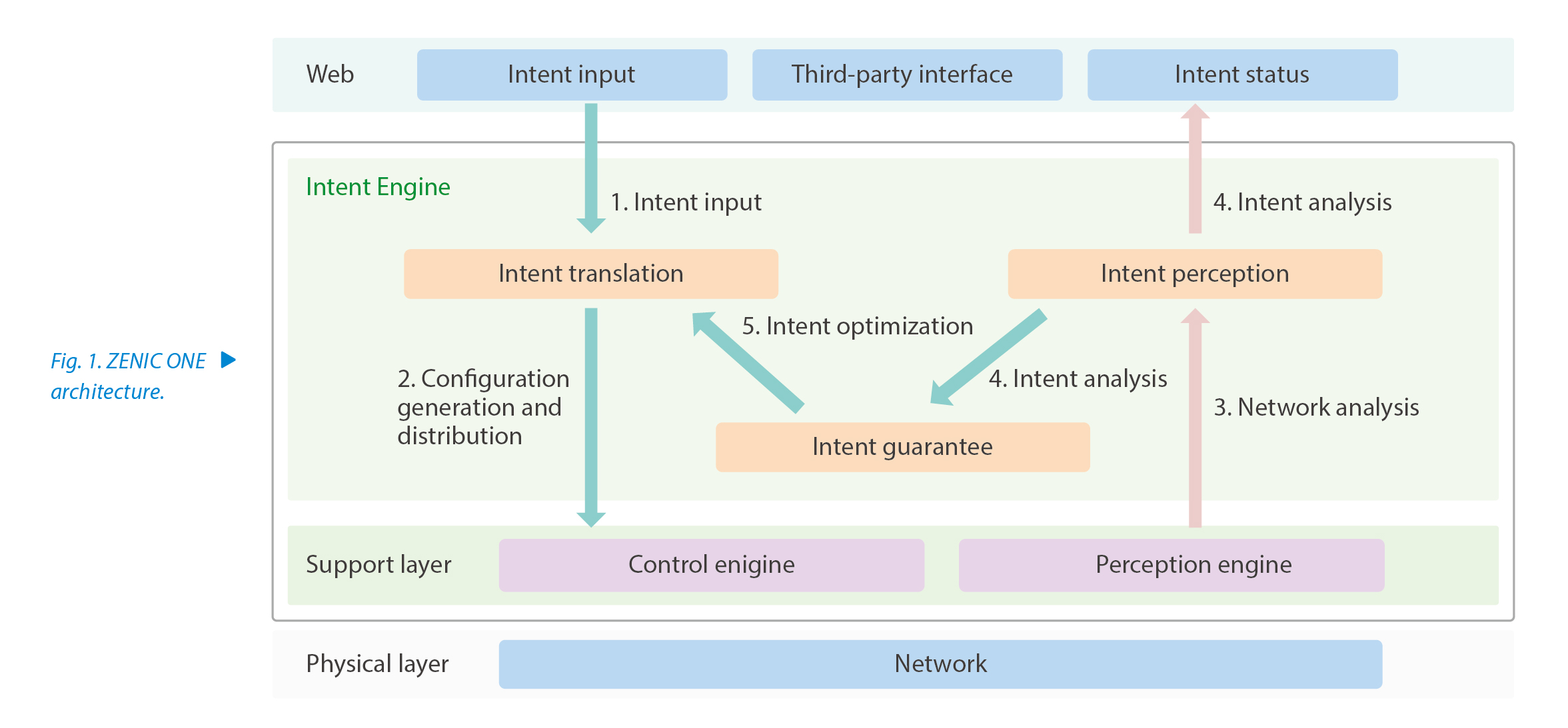Intent Network: Key to Autonomous Network
With the rapid development of globalization and informatization, the 5G network with customer experience as the center is accelerating the digital transformation of various industries. The intent-based network (IBN) technology oriented to 5G networks and combining SDN and AI has also become a hot topic for operators and manufacturers.
Since Gartner proposed the IBN concept in 2017, standard organizations such as 3GPP, ETSI and CCSA have also initiated research into IBN. With the introduction of IBN, network intelligence has a clear goal, gradually develops into self-planning, self-management, self-adaptation and self-optimization, and finally realizes the autonomous network.
Based on deep understanding of IBN, ZTE has launched Athena 2.0, the wireline intelligent network solution that contains the IBN-based full-lifecycle intelligent management and control system (ZENIC ONE). It has also cooperated closely with operators around the world to implement innovative intent-based functions. The intent-based automatic service provisioning is an innovative function of ZENIC ONE that continues to guarantee user intention, improves a service level agreement (SLA) by introducing big data and AI, and brings customers better service experience.
ZENIC ONE Architecture
The ZENIC ONE architecture consists of intent, control and perception engines (Fig. 1). As the link and bridge for interaction between O&M personnel and ZENIC ONE, the intent engine is the core of ZENIC ONE that contains intent translation, intent perception, and intent guarantee. The intent engine supports WEB and the third-party northbound interface. The intent management component (intent input) is responsible for inputting user intent, while the intent management component (intent status) for presenting the state in the intent lifecycle. The intent translation component interacts with the intent management component. After a user expresses his intent through voice, text, and other input modes, the intent translation component interacts with the user to ensure the integrity and defuzziness of the intent expression and build a bridge between the user and the machine. The intent perception component sends the analysis results to both the intent status and the intent guarantee components after analyzing network data reported by the perception engine based on the specific intent. The intent guarantee component carries out corresponding guarantee processing according to the established guarantee policies such as bandwidth adjustment, path adjustment, and protection/recovery SLA to ensure continued quality of user intent.

Automatic Service Provisioning Mechanism The automatic service provisioning capability can continuously assure user intent. When the system fails, network analysis is carried out through the AI technology and fed back to ZENIC ONE for self-decision to assure the user intent. The intent-based automatic service provisioning architecture of ZENIC ONE is based on the draft proposed by IETF.
For example, if there is an intent of a 5G base station in the transport network to access the L3VPN, the intent engine will set a series of templates associated with the intent. These templates describe how to modify L3VPN traffic that involves adding, deleting and modifying site data, and how to maintain the health of L3VPN or the blueprint for assurance graph.
The workflow of automatic service provisioning is illustrated in Fig. 2.
—The monitoring data of L3VPN traffic is collected by inband OAM (IOAM) mechanism. ZENIC ONE uses Netflow to automatically detect existing network traffic and create an end-to-end IOAM measurement task for the corresponding traffic.
—The BIGDNA module (perception engine) judges whether the measurement result of the IOAM task is abnormal. With the IOAM detection mechanism, abnormal flow, node and link can be located, reported and stored in the BIGDNA database.
—After receiving the report, the intent engine adjusts the state of the corresponding monitoring intent to unhealthy, determines whether there are routes to be adjusted and makes route adjustment.
—A new IOAM task is created after the switching. If the measurement result is normal, the intent engine will adjust the state of the monitoring intent state to healthy according to the result reported by BIGDNA.
—For a fault that cannot be fixed, the intent engine raises an alarm that the fault cannot be fixed, and the intentmanagement interface displays "automatic repair failure".
IOAM and Telemetry
The intent-based automatic service provisioning depends on the underlying core technology—IOAM. By adding flow ID tags into the traffic, IOAM can detect each network node that the traffic passes through one by one. Two original data such as the number of packets and timestamps can be measured. After summary and calculation by the controller, IOAM can obtain the following performance data:
—Number of packets sent and received in each detection period or the total number of packets sent and received in a period of time (several periods)
—Packet loss rate in each detection period or the average packet loss rate in a period of time (several periods)
—One-way/two-way delay of a packet in each detection period
—Delay jitter in a period of time (several periods).
Moreover, telemetry is used to achieve node-by-node reporting of millisecond-level performance data such as packet loss and delay. It is a technology that remotely collects data from physical or virtual devices at a high speed. The equipment periodically sends interface traffic statistics, CPU or memory data to the collector in a push mode. Compared with question-and-answer interaction of the traditional pull mode, telemetry provides a more real-time and higher-speed data collection.
Trial and Verification
Compared with the traditional service guarantee mechanism, the intent-based automatic service provisioning solution can achieve full-lifecycle closed-loop service provisioning from planning, creation to optimization. With the IOAM and telemetry technology, the solution can report information in milliseconds and locate fault in seconds. When combined with multiple SLA mechanisms of the controller, the solution can finally bring users zero perception when a fault occurs.
ZTE and China Mobile Zhejiang Branch have run a trial on the intent-based automatic service provisioning solution since the second half of 2020. They have verified and improved the solution to facilitate commercial deployment and intelligent O&M of the intent network and to accelerate large-scale commercial use of 5G transport networks.